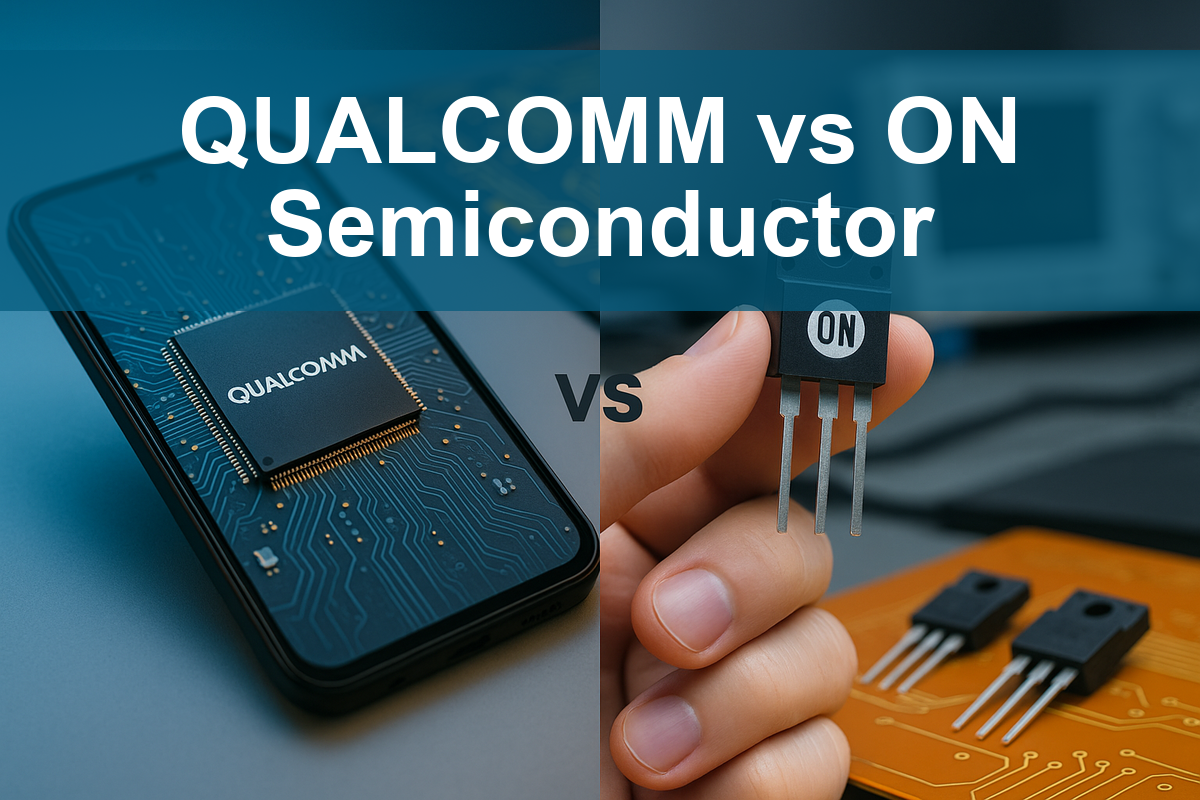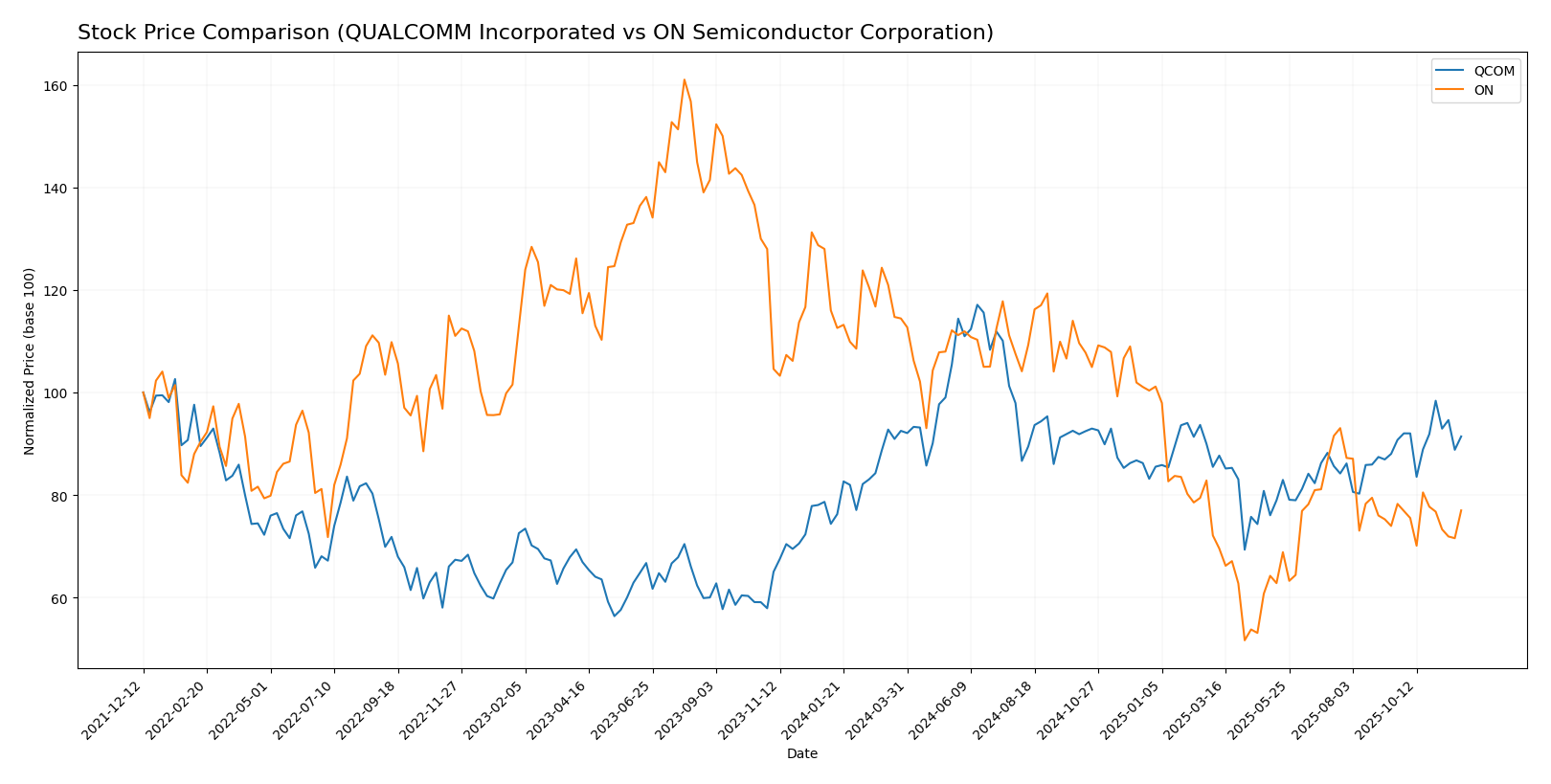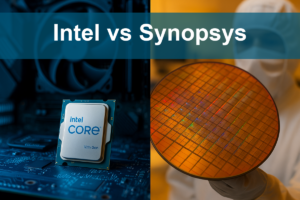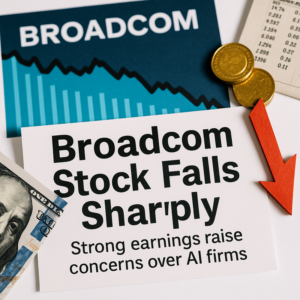In today’s rapidly evolving semiconductor landscape, understanding the competitive dynamics between key players is crucial for investors. I will compare QUALCOMM Incorporated (QCOM) and ON Semiconductor Corporation (ON), both of which operate in the same industry and share significant market overlap. While QUALCOMM focuses on wireless technologies and licensing, ON specializes in intelligent sensing and power solutions. As we delve deeper, I’ll help you determine which company presents the most intriguing investment opportunity.

Table of contents
Company Overview
QUALCOMM Incorporated Overview
QUALCOMM Incorporated (QCOM), headquartered in San Diego, California, is a leading player in the semiconductor industry, focusing on the development and commercialization of foundational technologies for the wireless sector. Founded in 1985, the company operates through three main segments: Qualcomm CDMA Technologies (QCT), Qualcomm Technology Licensing (QTL), and Qualcomm Strategic Initiatives (QSI). The QCT segment specializes in integrated circuits and system software for mobile communication technologies, while QTL grants licenses for its extensive intellectual property portfolio related to wireless standards, including 5G. Meanwhile, QSI invests in innovative companies across various industries, bolstering advancements in technologies such as AI and IoT. With a market cap of approximately $180B, QUALCOMM is pivotal in shaping the future of mobile communication.
ON Semiconductor Corporation Overview
ON Semiconductor Corporation (ON), based in Phoenix, Arizona, specializes in intelligent sensing and power solutions essential for the electrification of the automotive sector and sustainable energy initiatives. Established in 1992, ON operates through three major segments: Power Solutions Group, Advanced Solutions Group, and Intelligent Sensing Group. The company provides a wide array of semiconductor products designed for applications ranging from power management to image sensing. With a market cap of around $20.5B, ON is at the forefront of enabling advanced technologies like electric vehicles and renewable energy systems, positioning itself as a key player in the semiconductor landscape.
Key similarities and differences
Both QUALCOMM and ON Semiconductor operate within the semiconductor industry, focusing on technological innovation. However, their core competencies differ significantly; QUALCOMM emphasizes wireless communication technologies and licensing, while ON specializes in intelligent sensing and power solutions for automotive and energy sectors. This distinction highlights the varied applications of semiconductors in today’s technology-driven world.
Income Statement Comparison
In this section, I present a comparative analysis of the income statements for QUALCOMM Incorporated (QCOM) and ON Semiconductor Corporation (ON) for their most recent fiscal years.
| Metric | QCOM | ON |
|---|---|---|
| Market Cap | 180.02B | 20.54B |
| Revenue | 44.28B | 7.08B |
| EBITDA | 14.93B | 2.54B |
| EBIT | 13.33B | 1.90B |
| Net Income | 5.54B | 1.57B |
| EPS | 5.06 | 3.68 |
| Fiscal Year | 2025 | 2024 |
Interpretation of Income Statement
The income statements reveal that QUALCOMM experienced a notable revenue growth of approximately 13.5% compared to the previous year, while ON saw a decline in revenue from 8.25B in the prior year to 7.08B. Despite this, QUALCOMM’s net income decreased from 10.14B to 5.54B, indicating margin compression, likely due to increased costs in R&D and operating expenses. ON’s profitability improved slightly with a net income of 1.57B, reflecting efficiency gains. Overall, QCOM’s strong revenue growth contrasts with ON’s struggles, highlighting differing operational environments and cost management challenges.
Financial Ratios Comparison
In this section, I present a comparative analysis of key financial metrics for Qualcomm Incorporated (QCOM) and ON Semiconductor Corporation (ON). These metrics help assess the companies’ financial health, profitability, and efficiency.
| Metric | QCOM | ON |
|---|---|---|
| ROE | 26.13% | 17.88% |
| ROIC | 13.19% | 11.88% |
| P/E | 32.70 | 16.47 |
| P/B | 8.54 | 4.62 |
| Current Ratio | 2.82 | 5.06 |
| Quick Ratio | 2.10 | 3.38 |
| D/E | 0.70 | 0.43 |
| Debt-to-Assets | 29.54% | 25.42% |
| Interest Coverage | 18.61 | 33.94 |
| Asset Turnover | 0.88 | 0.62 |
| Fixed Asset Turnover | 9.44 | 1.61 |
| Payout Ratio | 68.67% | 0% |
| Dividend Yield | 2.10% | 0% |
Interpretation of Financial Ratios
Qualcomm demonstrates a strong return on equity (ROE) and return on invested capital (ROIC), indicating effective management of shareholder funds. However, its price-to-earnings (P/E) and price-to-book (P/B) ratios are significantly higher than ON’s, suggesting that QCOM may be overvalued. ON, with a higher current and quick ratio, exhibits better liquidity, while its lower debt ratios indicate a more conservative financial leverage. Both companies have strengths, but investors should consider QCOM’s high valuation compared to ON’s solid fundamentals.
Dividend and Shareholder Returns
QUALCOMM (QCOM) maintains a robust dividend policy, with a dividend payout ratio of 36.4% and a yield of approximately 1.94%. The company also engages in share buybacks, which enhances shareholder returns. ON Semiconductor (ON), however, does not pay dividends, reflecting a focus on reinvesting profits for growth and R&D. Despite the lack of cash distributions, ON is also involved in share repurchase programs. Both strategies appear aligned with long-term shareholder value creation, albeit through different approaches.
Strategic Positioning
QUALCOMM (QCOM) holds a significant share in the semiconductor market, especially with its advanced technologies in wireless communications, contributing to its robust market cap of $180B. Meanwhile, ON Semiconductor (ON), valued at $20.5B, is carving out its niche in automotive and power solutions, addressing the growing demand for electric vehicles. Both companies face competitive pressure from emerging players and must navigate technological disruptions to maintain their market positions effectively.
Stock Comparison
In the past year, both QUALCOMM Incorporated (QCOM) and ON Semiconductor Corporation (ON) have exhibited significant price movements, reflecting varying trading dynamics and investor sentiment.

Trend Analysis
QUALCOMM Incorporated (QCOM) has demonstrated a bullish trend with a price change of +22.94% over the past year. The stock has experienced notable acceleration in its upward trajectory, with a standard deviation of 16.77 indicating moderate volatility. The highest price recorded was 215.33, while the lowest was 127.46. Recently, from September 14 to November 30, 2025, QCOM’s price increased by 3.87%, showing continued bullish momentum.
ON Semiconductor Corporation (ON), on the other hand, has been on a bearish trend, reflecting a decline of -33.63% over the past year. This decline is characterized by an acceleration in downward movement, supported by a standard deviation of 12.59. The stock reached a high of 81.14 and a low of 33.7. In the recent period from September 14 to November 30, 2025, ON’s price increased by 4.1%, although this is insufficient to alter the overall bearish sentiment, particularly given the trend slope of -0.13.
Analyst Opinions
Recent analyst recommendations for QUALCOMM (QCOM) indicate a strong buy sentiment, with an overall rating of B+. Analysts highlight QCOM’s solid return on equity (5) and assets (5), alongside a favorable discounted cash flow score (4). ON Semiconductor (ON) has received a B rating, suggesting a hold position due to respectable scores in return on assets (4) but lower marks in price-to-earnings (1). The consensus for both stocks leans towards buying QCOM while maintaining a cautious hold on ON.
Stock Grades
In the current market landscape, stock ratings from reliable grading companies provide valuable insights for investors. Here are the latest grades for Qualcomm Incorporated and ON Semiconductor Corporation.
QUALCOMM Incorporated Grades
| Grading Company | Action | New Grade | Date |
|---|---|---|---|
| B of A Securities | maintain | Buy | 2025-11-06 |
| Piper Sandler | maintain | Overweight | 2025-11-06 |
| Wells Fargo | maintain | Underweight | 2025-11-06 |
| UBS | maintain | Neutral | 2025-11-06 |
| Rosenblatt | maintain | Buy | 2025-11-06 |
| Mizuho | maintain | Outperform | 2025-11-06 |
| JP Morgan | maintain | Overweight | 2025-11-04 |
| Rosenblatt | maintain | Buy | 2025-10-28 |
| Citigroup | maintain | Neutral | 2025-10-28 |
| UBS | maintain | Neutral | 2025-10-27 |
ON Semiconductor Corporation Grades
| Grading Company | Action | New Grade | Date |
|---|---|---|---|
| Morgan Stanley | maintain | Equal Weight | 2025-11-24 |
| Morgan Stanley | maintain | Equal Weight | 2025-11-04 |
| TD Cowen | maintain | Buy | 2025-11-04 |
| Truist Securities | maintain | Hold | 2025-11-04 |
| Baird | maintain | Neutral | 2025-11-04 |
| Rosenblatt | maintain | Neutral | 2025-11-04 |
| UBS | maintain | Neutral | 2025-10-27 |
| B of A Securities | maintain | Neutral | 2025-09-05 |
| JP Morgan | maintain | Neutral | 2025-08-05 |
| Truist Securities | maintain | Hold | 2025-08-05 |
Overall, both companies show a trend of maintaining their current grades, with Qualcomm receiving a mix of ‘Buy’ and ‘Neutral’ ratings, while ON Semiconductor is predominantly rated as ‘Equal Weight’ or ‘Neutral.’ This reflects a cautious but stable outlook in their respective market positions, suggesting that investors should closely monitor these stocks for any potential changes.
Target Prices
The consensus target prices for QUALCOMM Incorporated (QCOM) and ON Semiconductor Corporation (ON) reveal optimistic expectations from analysts.
| Company | Target High | Target Low | Consensus |
|---|---|---|---|
| QUALCOMM Incorporated | 210 | 165 | 190 |
| ON Semiconductor Corporation | 64 | 51 | 58.33 |
For QCOM, the current price of 168.09 suggests potential upside towards the consensus target of 190. Meanwhile, ON’s price of 50.235 is below its consensus target of 58.33, indicating room for growth.
Strengths and Weaknesses
The following table summarizes the strengths and weaknesses of QUALCOMM Incorporated (QCOM) and ON Semiconductor Corporation (ON) based on the most recent data.
| Criterion | QUALCOMM (QCOM) | ON Semiconductor (ON) |
|---|---|---|
| Diversification | Strong presence in wireless technology and IoT | Focus on automotive and power solutions |
| Profitability | Net profit margin: 12.5% | Net profit margin: 22.2% |
| Innovation | Leading in 5G technology | Strong R&D in power electronics |
| Global presence | Operates in over 160 countries | Presence in North America and Asia |
| Market Share | Holds significant share in mobile chipset market | Growing share in power semiconductor market |
| Debt level | Debt-to-equity ratio: 0.698 | Debt-to-equity ratio: 0.383 |
Key takeaways: QUALCOMM shows strong innovation and market share in wireless technologies, while ON Semiconductor excels in profitability and has a lower debt level, indicating a potentially more stable financial position. Investors should weigh these factors carefully.
Risk Analysis
In the following table, I outline the key risks associated with two prominent companies in the semiconductor industry, QUALCOMM Incorporated (QCOM) and ON Semiconductor Corporation (ON).
| Metric | QCOM | ON |
|---|---|---|
| Market Risk | High | Moderate |
| Regulatory Risk | Moderate | High |
| Operational Risk | Moderate | Moderate |
| Environmental Risk | Low | Moderate |
| Geopolitical Risk | High | Moderate |
Both companies face significant market and geopolitical risks, particularly given the semiconductor industry’s reliance on global supply chains. Recent tensions in international trade may impact operations and market access. Additionally, regulatory scrutiny is increasing, especially for ON, which operates in the automotive sector.
Which one to choose?
When comparing QUALCOMM (QCOM) and ON Semiconductor (ON), investors should consider several key factors. QUALCOMM has demonstrated strong profitability, reporting a net profit margin of 12.5% and a solid return on equity (ROE) of 26.1%. Its shares are currently rated B+ with a bullish stock trend, reflecting a recent price change of 22.94% over the past year. Conversely, ON has faced challenges, with a net profit margin of 22.2% and a bearish trend marked by a 33.63% decline in its share price. Its rating stands at B, indicating moderate performance.
For growth-oriented investors, I would recommend QUALCOMM due to its robust fundamentals and positive market sentiment. In contrast, conservative investors may find ON’s stability appealing, despite its recent performance struggles.
That said, both companies face industry risks such as competition and supply chain disruptions that could impact future performance.
Disclaimer: This article is not financial advice. Each investor is responsible for their own investment decisions.
Go further
I encourage you to read the complete analyses of QUALCOMM Incorporated and ON Semiconductor Corporation to enhance your investment decisions:



